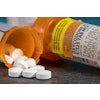
Two pain management experts discussed the role of dentists in the opioid crisis during a February 14 webinar jointly hosted by the ADA and the U.S. Centers for Disease Control and Prevention (CDC). The webinar focused on the best strategies to manage acute pain while also mitigating patients' risk for opioid misuse and dependency.
The one-hour webinar was led by Debbie Dowell, MD, MPH, the chief medical officer for the CDC Division of Unintentional Injury Prevention, and Paul Moore, DMD, PhD, MPH, the chair of the department of anesthesiology at the University of Pittsburgh School of Dental Medicine. Both speakers elaborated on the role that dentists play in the opioid crisis and how opioid prescriptions from dental professionals are intertwined with the larger healthcare ecosystem.
"Thirty years ago, that patient in my chair was my only concern," said Dr. Moore, who is also a member of the ADA Council on Scientific Affairs. "In that same broadening of our professional responsibilities, we need to counsel patients and think about what happens when patients don't use all of their prescriptions."
Dentists' role in the opioid crisis
 Debbie Dowell, MD, MPH, chief medical officer of the CDC Division of Unintentional Injury Prevention.
Debbie Dowell, MD, MPH, chief medical officer of the CDC Division of Unintentional Injury Prevention.Opioids have proved to reduce severe, acute pain and help relieve pain associated with cancer and end-of-life conditions. However, their benefits are questionable for long-term pain relief, which is why the CDC created guidelines in 2016 that outline opioid prescription practices for chronic pain management. Although dentists generally don't manage chronic pain, Dr. Dowell, who was the lead author of the guidelines, said that dentists should know three key points.
First, they should limit opioid prescriptions for acute pain to no more tablets than are necessary. This means prescribing the lowest effective dose for each patient and opting for immediate-release opioids instead of extended-release or long-acting opioid analgesics.
Second, dental professionals should check prescription drug monitoring program data before writing an opioid prescription. Consulting state databases can help identify patients who already have strong opioid prescriptions or who have prescriptions from multiple healthcare providers.
“Use the opportunity to provide potentially lifesaving information and interventions.”
Finally, dental professionals should be ready to intervene when necessary. If you suspect a patient has an opioid use disorder, it's important to discuss your concerns with the patient to provide an opportunity for the patient to disclose his or her concerns and to arrange for an assessment by a substance use disorder specialist. Most important, do not dismiss that patient from care, a point that Dr. Dowell stressed several times.
"Use the opportunity to provide potentially lifesaving information and interventions," she said.
Best prescribing practices
Although dentists may not be top prescribers for long-term opioid prescriptions, dental professionals write 12% of all immediate-release prescriptions, according to Dr. Moore. Furthermore, dentists and oral surgeons are often the first healthcare professionals to prescribe opioids to adolescents and young adults, and research has repeatedly shown that short-term exposure to opioids for acute pain can result in long-term opioid use.
 Paul Moore, DMD, PhD, MPH, is the chair of the department of anesthesiology at the University of Pittsburgh School of Dental Medicine.
Paul Moore, DMD, PhD, MPH, is the chair of the department of anesthesiology at the University of Pittsburgh School of Dental Medicine.For instance, being prescribed an opioid for just one day is associated with a 6% increase in the probability of continued use within a year, Dr. Moore said. Data from thousands of 12th-grade students also show that legitimate opioid use before high school graduation is independently associated with a 33% increase in the risk of future opioid misuse afterward, he noted.
"A 33% increase is not a lot, but it is surprising," Dr. Moore said. "Here's a group of kids who are at low risk, who are getting through life really well and not doing risky behaviors, but a prescription for a legitimate opioid -- Vicodin following getting your wisdom teeth taken out -- appears to have an increased risk of misusing opioids."
Furthermore, many patients do not use all the opioids prescribed to them. A study found that 18-year-old patients have an average of 60% of their opioid tablets leftover after third-molar extractions, Dr. Moore said. When these extra pills aren't properly disposed of, they may get misused by patients or the patient's friends and families.
So how can this risk be mitigated? The CDC has found that three days' worth of opioids for acute pain is sufficient for most patients, and more than seven days of opioid medication is rarely necessary.
 Data from "Improving Opioid Prescribing: The CDC Guidelines for Prescribing Opioids for Chronic Pain, and Considerations for Dentistry," ADA/CDC, February 24, 2018.
Data from "Improving Opioid Prescribing: The CDC Guidelines for Prescribing Opioids for Chronic Pain, and Considerations for Dentistry," ADA/CDC, February 24, 2018.In addition, dentists and oral surgeons should consider using nonsteroidal medication as a first-line resource for treating acute pain. In fact, multiple studies have found that opioids may not be as effective for treating acute pain as a combination of ibuprofen and acetaminophen.
"This is not to say that opioids may not be needed," Dr. Moore said. "But in proposing and managing pain, the nonsteroidals should be considered first."
Finally, dentists should consider consulting with pain management specialists when managing chronic orofacial pain, and they should educate patients about the risks of opioid drugs.
"This may be a teaching opportunity -- a time when you can actually talk to a young person about the dangers of opioid analgesics and to include parents in that picture," Dr. Moore said.



















